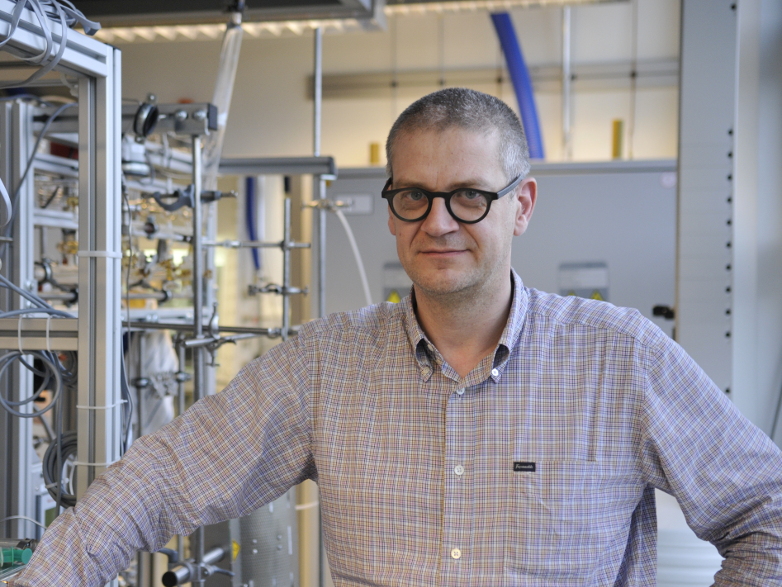"Oil for the Swiss engine of innovation"
By replacing the CTI and launching the Innosuisse funding agency on 1 January 2018, the federal government intends to give an additional boost to innovation in Switzerland. As one of the 21 members of the Innovation Council, the ETH Chemistry Professor Christophe Copéret is closely involved.

ETH-News: Mr Copéret, between 2017 and 2020 Innosuisse will have around CHF 950 million at its disposal. How can ETH Zurich researchers benefit from this?
Christophe Copéret: Innosuisse offers research groups and researchers, including senior doctoral students and early post-doctoral fellows, excellent opportunities to turn their knowledge and ideas into marketable products – either together with Swiss industry or by founding start-ups. In terms of content, Innosuisse focuses on information and communication technology, life sciences, energy and environment, as well as management and social sciences. In other words, the door is now wide open for ETH to create momentum for the economy in these fields.
From an ETH viewpoint, the Swiss National Science Foundation (SNSF) is more likely to be considered when it comes to funding. What is the difference between the two instruments?
Innosuisse focuses on strengthening technology transfer, and in this way accelerates innovation, which is so crucial for the Swiss economy and society. The SNSF, on the other hand, targets long-term research exploring the limits of existing knowledge, and international and interdisciplinary projects. The two funding options complement each other effectively. By the way, since 2016, the interface between the two institutions has been covered by the Bridge programme, run jointly by Innosuisse and SNSF.
To found a start-up, a researcher needs business and management skills. Can Innosuisse sponsorship also be used to fine-tune this?
Yes, that’s absolutely correct. Innosuisse helps researchers who want to become CEOs of start-ups with coaching and training, and supports the implementation of business ideas from the earliest stages, for example by developing a strategy. And very importantly, it also clarifies with researchers how the young company can grow and get onto a solid footing. Together with ETH's own offerings, namely those of ETH Transfer, there is now a close-knit and effective funding and support network. The tailor-made range of support services is probably the most interesting new aspect of the switch from CTI to Innosuisse.
Where does ETH Zurich position itself in the competition for funding, and generally in the Swiss innovation landscape? ETH research is often just associated with basic research.
That's not quite true. The division into basic and applied science is an artificial one: basic research at the highest level has always led to discoveries which have been turned into important technology. Just think of Pasteur, who discovered chirality, a fundamental phenomenon in chemistry, while working on fermentation processes and vaccines. Or, in relation to us, how ETH Zurich has contributed to making the new Swiss banknotes secure. We researchers should therefore consider the possibility of knowledge transfer in everything we do in the laboratories.
And I might add – I can well imagine collaborations where ETH Zurich and the universities of applied sciences each contribute their strengths to shape the increasingly knowledge-based Swiss economy of the 21st century.
And what role does teaching play in all this?
You can't overestimate it. One of ETH's central tasks is to train the next generation of leaders. The most promising way to do this is not only to convey in-depth knowledge and critical thinking, but also to work closely with the global and local economies.
You talk about local companies: Could ETH Zurich be more proactive in approaching smaller companies in order to promote innovation?
I think there’s still great potential in this area. Switzerland has countless small and medium-sized enterprises that stand their ground in the face of tough global competition. A look abroad shows that all leading universities are part of both the local and global economy. In addition to training first-class engineers for Switzerland, ETH Zurich can help small and medium-sized companies by giving them access to the latest research results and innovation, along with continuing education programmes. Where there are obstacles, these often lie in the costs of research and knowledge transfer. Innosuisse is the ideal instrument for lowering and removing these hurdles. It is the oil that the Swiss innovation engine needs from time to time to continue to run at high speed.
Innosuisse roadshow stops at ETH Zurich
What structural changes does Innosuisse bring? Will the current funding instruments be continued? Will Innosuisse offer new funding instruments? Innosuisse will present itself at ETH Zurich on 6 December, from 2 pm to 5.15 pm, at HG E 3. Experts and those responsible, such as Innosuisse Director Annalise Eggimann, will answer questions from interested ETH members on the move from CTI to Innosuisse.

